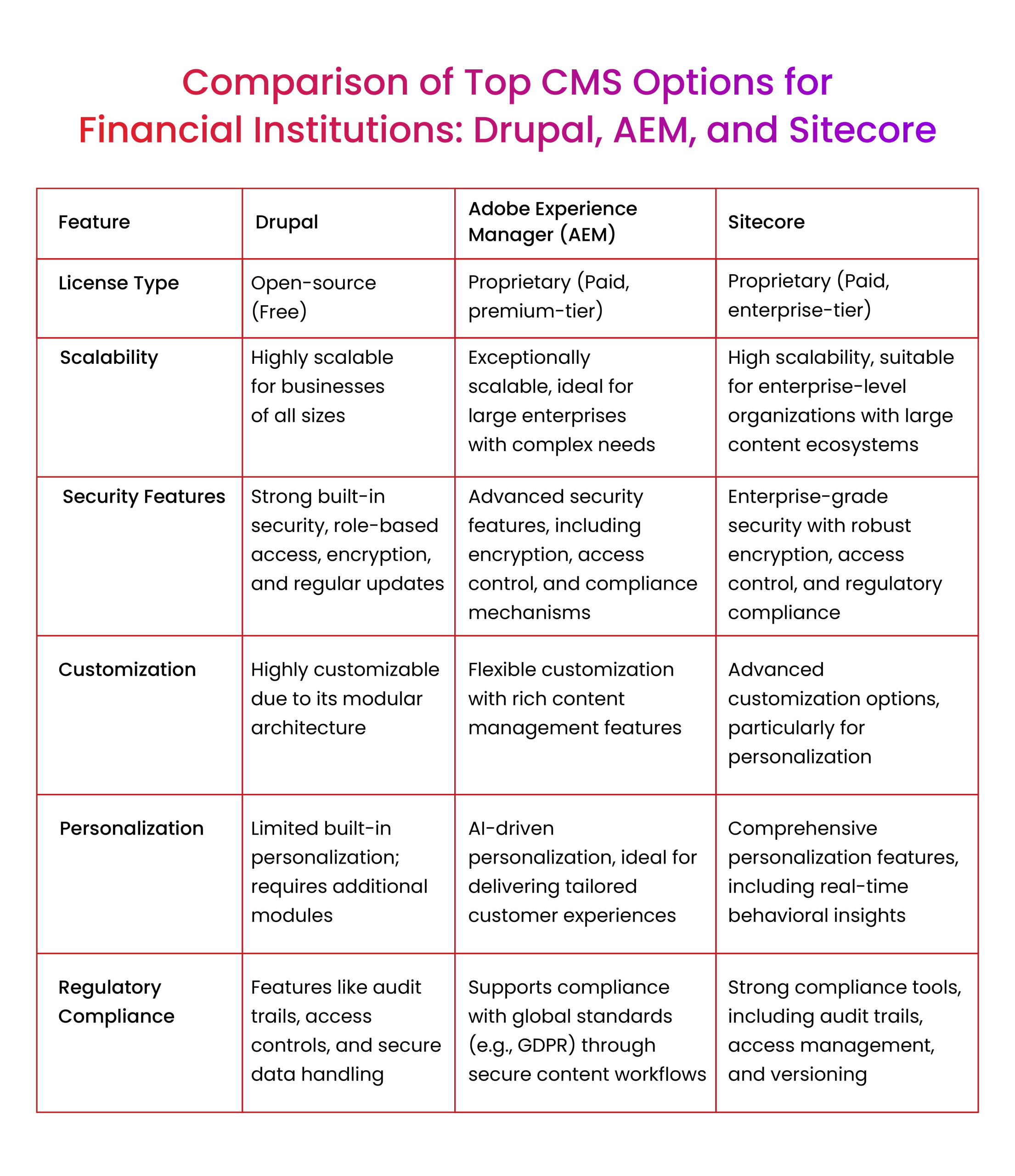The BFSI (Banking, Financial Services, and Insurance) industry operates in a highly regulated environment where managing complex financial content is crucial for maintaining transparency, trust, and regulatory compliance. Many financial institutions possess vast amounts of sensitive information from customer details to financial documents and therefore, this content needs a robust system for managing this content effectively.
Understanding the regulations governing financial services is going to be part of the sustainability planning for financial services organizations, as there are awful penalties for violating regulations, such as fines or being sanctioned, and corporate responsibility is sometimes taken into consideration. Banking, which is a subsector of the financial industry, requires reliable web development aids that will cater for security, remain compliant to regulations and still provide ease of interaction with clients. In this sense, a content management system (CMS) can be properly integrated within these institutions to assist with managing financial content without violating regulatory policies.
CMS platforms like Drupal, Sitecore, Adobe Experience Manager(AEM) have gained popularity amongst financial services organizations because they are reliable, flexible and easy to use thereby enhancing their abilities to manage financial content in a compliant manner. This blog will focus on addressing the role played by CMS in managing financial documents and contents, the challenges of regulatory compliance and what the environment of a good content management system can be to mitigate these shortcomings.
Understanding Financial Content Management
Financial content management is the process of availing entire financial information to customers, investors, regulators or internal teams. In stringent terms of the BFSI industry, it could mean a number of documents such as financial statements, transaction history, customer particulars, KYC documents, and other compliance.
There are many reasons why efficient financial content management is helpful:
- The management assists to guarantee the precision, relevance and compliance of content.
- It builds customer and investor confidence levels and transparency
. - It allows for streamlined workflows that reduce operational costs and inefficiencies.
- It supports timely decision-making by enabling easy access to critical financial data.
Benefits of Effective Financial Content Management
- Improved Customer Engagement and Experience
Proper deployment of CMS assists in delivering relevant and timely content and services that enhances customer’s interaction with financial institutions. - Enhanced Brand Reputation and Credibility
The management of efficient content improves accountability and this is a core ingredient to the reputation and credibility with customers and regulators. - Increased Operational Efficiency
Automation and streamlined processes reduce reliance on manual work, raise accuracy, and eventually save costs. - Better Compliance with Regulatory Requirements
Financial content management is proposed to help institutions abide by the allowable limits with respect to the strict regulatory policies mitigating the chances of sanctions.

AEM, Drupal, Sitecore are few specific content management systems that help to increase the sales cycle of the companies in the financial services sector through strong integration with their CRM systems functionalities and lead generation opportunities.
Challenges in Managing Financial Content and Regulatory Compliance
The BFSI industry deals with collection of complex data, such as financial transactions or investment portfolios. The problem arises, however, for financial entities in managing such data, sustaining its accuracy, and keeping the data compliant with the shifting rules and regulations. This complexity is further exacerbated by the integration of data obtained from multiple sources making the achievement of uniformity and precision a daunting task.
Key Regulatory Requirements Impacting Content Management
Some of the key regulatory requirements in the BFSI sector include:
- General Data Protection Regulation (GDPR): Regulates the use of personal data in the European Union.
- Payment Card Industry Data Security Standard (PCI-DSS): It deals with the secure handling of credit cards.
- Sarbanes-Oxley Act (SOX): It deals with establishment of audit and financial disclosures policies.
- Dodd-Frank Act and Basel III: Targets improving risks through increased visibility and accountability.
Each regulation presents unique challenges in terms of how financial institutions must manage and protect their data. Non-compliance with these regulations can expose the legal persons to sanctions, fines, and a loss of reputation.
Common Challenges in Financial Content Management
- Data Security
Financial institutions handle sensitive customer data that must be protected from breaches and cyberattacks. - Audit Trails
Maintaining accurate records of all financial transactions and changes to content is critical for compliance with regulatory bodies. - Accuracy and Timely Updates
Ensuring that all financial content is accurate and updated in real-time is essential to avoid discrepancies and regulatory issues.
The Role of a Content Management System in BFSI
A CMS helps financial institutions manage complex content efficiently, ensuring regulatory compliance and secure content handling. It enhances operational efficiency and delivers personalized customer experiences.
Benefits of Using a CMS for Financial Institutions
A CMS provides financial institutions with a structured system for managing their complex content while addressing compliance requirements. Some of the key benefits include:
- Improved Content Management and Distribution
A CMS enables financial institutions to centralize their content, making it easier to manage and distribute to the appropriate stakeholders. - Enhanced Customer Experience and Engagement
With features like personalization and automated workflows, a CMS helps deliver timely and relevant content to customers. - Increased Operational Efficiency
By automating repetitive tasks and improving workflow management, a CMS reduces manual errors and increases productivity. - Better Compliance with Regulatory Requirements
A CMS provides tools to manage data securely, implement audit trails, and ensure compliance with evolving regulations.
Security and compliance play a critical role in protecting sensitive information and maintaining client confidence for financial organizations, particularly in light of increasing regulatory pressures and risks.
Top CMS Options for Financial Institutions
1.Drupal
Drupal is one of the highly popular open-source CMS for financial institutions, known for its advanced security, flexibility, and scalable architecture. With role based access control at the core, secure login, and data encryption, sensitive financial information is assured of as well protected. Its modular design gives financial institutions the ability to tailor the platform to their requirements, allowing seamless links to other systems such as CRM and LMS.
Within the BFSI sector where adherence to compliance is paramount, Drupal’s capabilities of handling complex workflows, allowing for audit trails, and compliance reports make it suitable for the industry. Also, Drupal’s active community and regular security patches make it possible for the financial entities to use the platform on a long-term basis with guaranteed support and efficiency.
2. Sitecore
Sitecore is an enterprise-level CMS designed for large financial organizations that require robust content management, advanced integrations, and scalability. Known for its rich set of features, Sitecore offers comprehensive personalization capabilities, allowing financial institutions to deliver tailored experiences to customers based on their interactions and preferences.
Sitecore connects effortlessly with core banking operations, customer relationship management systems and Data Analytics, making customer data and content management together. Security is one of Sitecore’s greatest strengths with powerful encryption, access management and ability to comply with laws such as GDPR. Its scalability is beneficial to financial businesses that must oversee a great deal of content and transactions over various systems while ensuring great user experience and security.
3. Adobe Experience Manager (AEM)
Adobe Experience Manager (AEM) is a premium content management system designed to deliver personalized, scalable and highly interactive digital experiences. In the BFSI sector, AEM does great, as it is designed to work with considerable amounts of content, ensuring its coherence across various touchpoints.
Due to AEM’s seamless integration with Adobe Analytics, CRM, and marketing tools, financial institutions can derive insights and focus on delivering enhanced experiences. Such modern and advanced features such as encryption, control over the access to sensitive information and full compliance to the country’s data protection laws such as GDPR makes it one of the reliable financial data management. AEM’s content automation tools and AI-driven personalization enhance operational efficiency, while its scalability ensures it can adapt to the growing needs of financial organizations.

Compliance and Regulatory Requirements: An Overview
Financial institutions must comply with various regulatory frameworks that govern how they manage customer data and financial content. Some of these regulations include:
- GDPR
Mandates that financial institutions protect the personal data of EU citizens, ensuring that it is securely stored and managed. - FINRA Rules
Regulates how financial firms handle customer communications and interactions to ensure transparency.
Non-compliance can result in regulatory sanctions, fines, and reputational damage.
Ensuring Regulatory Compliance with a CMS
A CMS can help financial institutions meet these regulatory standards by offering:
- Document Retention and Access Control
CMS platforms such as Drupal include features that allow document retention policies to be implemented and that ensures that sensitive data is only available to certain people with authority. - Access Based on Role and Security of Data
The introduction of role-based access control mechanisms in financial institutions will guarantee that staff have access to only the relevant data needed thereby minimizing risks of data breach. - Automated Compliance Reporting and Audit Trails
A CMS does not only facilitate the creation of compliance reports but can also provide audit trails making it easier for institutions to comply with various regulations. - Content that is Up to Date
CMS platforms will be able to keep the financial sector’s content compliant with current requirements through the timely incorporation of new policies.
Mitigating Compliance Risk
Failure to comply fully with regulations, policies, and guidelines is detrimental to a financial institution, and therefore there is a need for appropriate compliance risk management measures such as:
- Regular Risk Assessments
Conducting periodic risk assessments to identify potential compliance gaps. - Policies and Procedures
Establishing and enforcing policies that align with regulatory requirements. - Employee Training
Providing ongoing training to employees on compliance policies and procedures.
Customer Data Management and Its Relevance for Financial Institutions
Customer data is at the heart of the BFSI sector, driving personalized services, risk management, and compliance. Financial institutions must secure and manage customer data effectively to maintain trust and comply with regulations like GDPR.
Customer Data Management Strategies
- Robust Data Governance Policies
Establishing clear policies to ensure data security and integrity. - Data Analytics
Using data analytics to gain insights that improve customer experiences. - Compliance with Data Protection Regulations
Ensuring that all data management practices align with GDPR and other regulatory frameworks.
Workflow Management and Approval Processes in CMS
Efficient workflow management is essential for ensuring compliance in financial institutions. A CMS offers features like:
- Role-Based Workflows
In Drupal, workflows can be tailored to assign specific roles for content approval, ensuring compliance at every stage. - Audit Logs
Tracking changes in real-time and maintaining a detailed log of who accessed or modified content helps maintain transparency and accountability.
CMS Security Features for Financial Content
Security is paramount for financial institutions. CMS platforms like Drupal offer:
- Encryption
Protecting data through encryption ensures that even if unauthorized access occurs, the data remains secure. - Secure Login Mechanisms
Multi-factor authentication (MFA) and other secure login options safeguard against unauthorized access. - Regular Updates and Security Patches
Staying up-to-date with security patches is essential to protecting against vulnerabilities.
Choosing the Right CMS for Financial Institutions
Choosing the right Content Management System (CMS) is crucial for financial institutions to manage their online presence effectively. A CMS that aligns with the institution’s needs can help streamline content management, improve customer experience, and ensure compliance with regulatory requirements. Financial institutions must carefully evaluate their options to find a CMS that offers robust security, scalability, and the ability to handle complex regulatory requirements.
Factors to Consider When Selecting a CMS
When selecting a CMS, financial institutions should consider the following factors:
- Security: The CMS should have robust security features to protect sensitive customer data and prevent cyber threats. This includes encryption, secure login mechanisms, and regular security updates to safeguard client data.
- Compliance: The CMS should be able to handle complex regulatory requirements, such as the General Data Protection Regulation (GDPR) and other financial industry-specific regulations. Ensuring compliance with these regulations is critical to avoid regulatory sanctions and maintain trust.
- Scalability: The CMS should be able to handle high traffic and large volumes of content, ensuring that the website remains responsive and efficient. This is particularly important for financial institutions that deal with a vast amount of financial data and customer interactions.
- Customization: The CMS should offer flexibility in terms of design and functionality, allowing the institution to tailor the website to its specific needs. Customization options enable financial institutions to create a unique online presence that aligns with their brand and operational requirements.
- Integration: The CMS should be able to integrate with other systems, such as customer relationship management (CRM) software and core banking systems. Seamless integration ensures that all systems work together efficiently, providing a cohesive experience for both the institution and its customers.
Aligning CMS Features with Institutional Needs
Financial institutions should align the CMS features with their specific needs, such as:
- Content management: The CMS should have features that enable easy creation, editing, and publishing of content, including financial reports, news, and product information. Effective content management ensures that all information is accurate, up-to-date, and accessible to stakeholders.
- Customer data management: The CMS should have features that enable secure storage and management of customer data, including personal and financial information. Protecting customer data is paramount to maintaining trust and complying with data protection regulations.
- Risk management: The CMS should have features that enable risk management, such as monitoring and reporting tools to detect potential security threats. Proactive risk management helps financial institutions mitigate operational risk and protect their financial system.
- Compliance management: The CMS should have features that enable compliance management, such as audit trails and version control to track changes to content and data. These features ensure that financial institutions can demonstrate compliance with regulatory requirements and avoid potential fines and reputational damage.
CMS Features for Managing Complex Financial Content
A CMS for financial institutions should have the following features to manage complex financial content:
Key Features for Compliance and Efficiency
- Document management: The CMS should have features that enable secure storage and management of financial documents, such as reports and statements. This ensures that all documents are easily accessible and protected from unauthorized access.
- Workflow management: The CMS should have features that enable workflow management, such as approval processes and version control to ensure that content is accurate and up-to-date. Efficient workflow management helps streamline content creation and approval, reducing the risk of errors and non-compliance.
- Audit trails: The CMS should have features that enable audit trails, such as tracking changes to content and data to ensure compliance with regulatory requirements. Audit trails provide a transparent record of all changes, which is essential for regulatory compliance and internal audits.
- Reporting and analytics: The CMS should have features that enable reporting and analytics, such as monitoring website traffic and customer engagement to improve customer experience. These insights help financial institutions make data-driven decisions and enhance their online presence.
- Integration with core banking systems: The CMS should have features that enable integration with core banking systems, such as account management and transaction processing to provide a seamless customer experience. Integration ensures that all systems work together efficiently, enhancing operational efficiency and customer satisfaction.
By considering these factors and features, financial institutions can choose a CMS that meets their specific needs and ensures compliance with regulatory requirements, while also improving customer experience and operational efficiency.
Conclusion
In the BFSI sector, managing complex financial content while ensuring regulatory compliance is a significant challenge. A robust CMS, like Drupal, offers financial institutions the tools they need to streamline content management, enhance security, and ensure compliance with ever-evolving regulatory requirements.
By leveraging the right CMS, financial institutions can improve operational efficiency, build stronger relationships with customers, and maintain the highest standards of transparency and trust. With features such as document management, workflow automation, and robust security, CMS platforms are indispensable for the financial sector’s future.









































